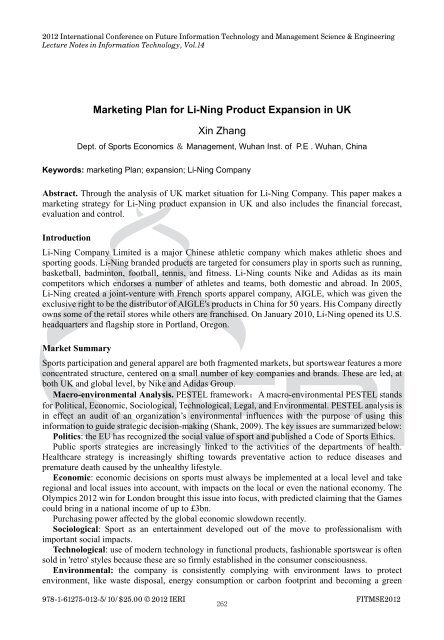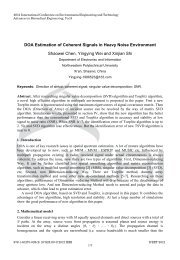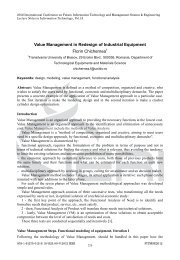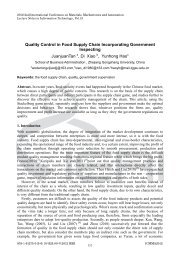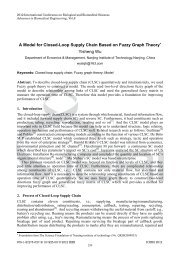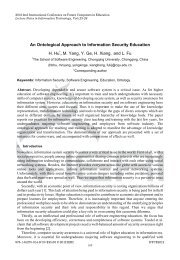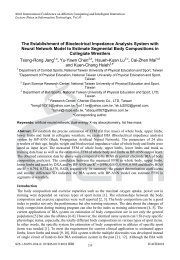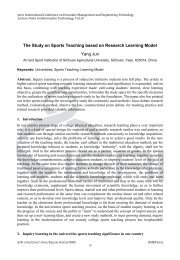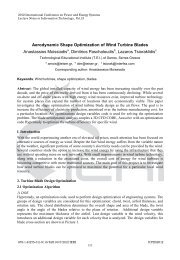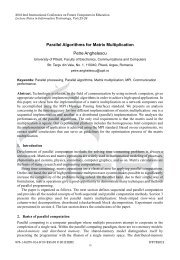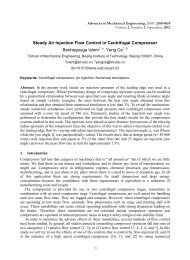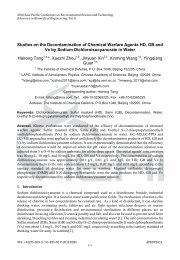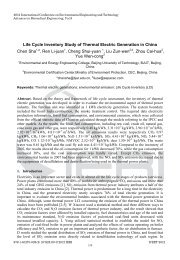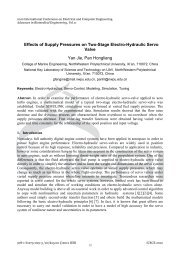Marketing Plan For Li-Ning Product Expansion In - IERI: Information ...
Marketing Plan For Li-Ning Product Expansion In - IERI: Information ...
Marketing Plan For Li-Ning Product Expansion In - IERI: Information ...
You also want an ePaper? Increase the reach of your titles
YUMPU automatically turns print PDFs into web optimized ePapers that Google loves.
2012 <strong>In</strong>ternational Conference on Future <strong>In</strong>formation Technology and Management Science & Engineering<br />
Lecture Notes in <strong>In</strong>formation Technology, Vol.14<br />
<strong>Marketing</strong> <strong>Plan</strong> for <strong>Li</strong>-<strong>Ning</strong> <strong>Product</strong> <strong>Expansion</strong> in UK<br />
Xin Zhang<br />
Dept. of Sports Economics & Management, Wuhan <strong>In</strong>st. of P.E . Wuhan, China<br />
Keywords: marketing <strong>Plan</strong>; expansion; <strong>Li</strong>-<strong>Ning</strong> Company<br />
Abstract. Through the analysis of UK market situation for <strong>Li</strong>-<strong>Ning</strong> Company. This paper makes a<br />
marketing strategy for <strong>Li</strong>-<strong>Ning</strong> product expansion in UK and also includes the financial forecast,<br />
evaluation and control.<br />
<strong>In</strong>troduction<br />
<strong>Li</strong>-<strong>Ning</strong> Company <strong>Li</strong>mited is a major Chinese athletic company which makes athletic shoes and<br />
sporting goods. <strong>Li</strong>-<strong>Ning</strong> branded products are targeted for consumers play in sports such as running,<br />
basketball, badminton, football, tennis, and fitness. <strong>Li</strong>-<strong>Ning</strong> counts Nike and Adidas as its main<br />
competitors which endorses a number of athletes and teams, both domestic and abroad. <strong>In</strong> 2005,<br />
<strong>Li</strong>-<strong>Ning</strong> created a joint-venture with French sports apparel company, AIGLE, which was given the<br />
exclusive right to be the distributor of AIGLE's products in China for 50 years. His Company directly<br />
owns some of the retail stores while others are franchised. On January 2010, <strong>Li</strong>-<strong>Ning</strong> opened its U.S.<br />
headquarters and flagship store in Portland, Oregon.<br />
Market Summary<br />
Sports participation and general apparel are both fragmented markets, but sportswear features a more<br />
concentrated structure, centered on a small number of key companies and brands. These are led, at<br />
both UK and global level, by Nike and Adidas Group.<br />
Macro-environmental Analysis. PESTEL framework:A macro-environmental PESTEL stands<br />
for Political, Economic, Sociological, Technological, Legal, and Environmental. PESTEL analysis is<br />
in effect an audit of an organization’s environmental influences with the purpose of using this<br />
information to guide strategic decision-making (Shank, 2009). The key issues are summarized below:<br />
Politics: the EU has recognized the social value of sport and published a Code of Sports Ethics.<br />
Public sports strategies are increasingly linked to the activities of the departments of health.<br />
Healthcare strategy is increasingly shifting towards preventative action to reduce diseases and<br />
premature death caused by the unhealthy lifestyle.<br />
Economic: economic decisions on sports must always be implemented at a local level and take<br />
regional and local issues into account, with impacts on the local or even the national economy. The<br />
Olympics 2012 win for London brought this issue into focus, with predicted claiming that the Games<br />
could bring in a national income of up to £3bn.<br />
Purchasing power affected by the global economic slowdown recently.<br />
Sociological: Sport as an entertainment developed out of the move to professionalism with<br />
important social impacts.<br />
Technological: use of modern technology in functional products, fashionable sportswear is often<br />
sold in 'retro' styles because these are so firmly established in the consumer consciousness.<br />
Environmental: the company is consistently complying with environment laws to protect<br />
environment, like waste disposal, energy consumption or carbon footprint and becoming a green<br />
978-1-61275-012-5/10/$25.00 ©2012 <strong>IERI</strong> FITMSE2012<br />
262
efficient customer.<br />
Mico-environmental Analysis<br />
Market Size/ Growth. Evaluated by the terms of direct consumer spending in sports market, the<br />
overall market was worth exactly £10bn in 2008, and is provisionally estimated to have fallen to<br />
£9.85bn in 2009 as the recession took hold and trends continued away from formal, competitive<br />
sports and `equipped' sports.<br />
The basic reasons for relatively low consumer spending are twofold: the ability to follow<br />
professional sport in the media (mainly television) at a low cost to the consumer; and the government<br />
subsidy provided for sports participation in terms of local facilities. Furthermore, the trend to `pure'<br />
fitness activity such as road running or aerobics classes, away from competitive, `equipped' sports,<br />
has reduced spending on equipment, at least in relative terms.<br />
Market Demographics. A socio-demographic analysis by age shows that buying sports clothing<br />
is important through to the early 40s, but then dwindles in the 45 to 54 age group. The class<br />
breakdown shows that the propensity to wear `sporty' garments increases with status, but peaks in the<br />
group for both men and women.<br />
Geographic market segmentation. There are a number of different factors to consider with<br />
regards to the geographic scope of the market. The major retailers are national chains, whose pricing<br />
is generally determined on a national level. The larger cities and shopping centers, for example, will<br />
generally sell a greater amount and a greater range of products.<br />
With the increasing use of the internet, consumers are able purchase products from a wide number<br />
of competing sources, both on a national or possibly even international level.<br />
Consumer Markets. Sportswear can easily be the largest individual market, but this includes<br />
purchasing of sportswear to use as leisurewear or casual clothing (e.g. multi-purpose trainers as<br />
casual shoes). It is now impossible to distinguish between the `fashion or function' markets.<br />
Functional items are extremely diverse, with some important niche markets being running shoes,<br />
fleece tops for outdoor pursuits. The sportswear market is driven by strong branding and globalised<br />
manufacturing, led by two giant brands which are Nike and Adidas.<br />
Competitor Analysis. Competitor analysis in marketing and strategic management is an<br />
assessment of the strengths and weaknesses of current and potential competitors. This analysis<br />
provides both an offensive and defensive strategic context through which to identify opportunities<br />
and threats (Fleisher, 2003).<br />
Competitor analysis can instruct <strong>Li</strong>-<strong>Ning</strong> to understanding of competitors' past, present and most<br />
importantly the future strategies, and understanding their advantages or disadvantages relative to<br />
competitors (Fleisher, 2003). With this competitor analysis, <strong>Li</strong>-<strong>Ning</strong> also can forecast the returns that<br />
may be made from future investments.<br />
Direct competition. <strong>Li</strong>-<strong>Ning</strong> has to face the direct competition from those global sports brands<br />
which already existed in UK sportswear market, such as Nike, Adidas, Puma and and also private<br />
quoted companies locally in UK, such as, Pentland Group and Hi-Tec Sports. .<br />
<strong>In</strong>direct competition. The indirect competition to <strong>Li</strong>-<strong>Ning</strong>'s sportswear come from leisure<br />
clothing and footwear retailers which can instead of household clothing and footwear budgets. Sports<br />
equipment or travel may also threaten the consumption on sportswear.<br />
SWOT Analysis. One of the basic tools in the environmental analysis is called the SOWT analysis.<br />
This form of analysis is used to examine an organization's strategic positions, from the inside to the<br />
outside (Hoye, 2009). A detailed SWOT analysis of <strong>Li</strong>-<strong>Ning</strong> is provided in Appendix 8.2.1 and the<br />
key issues are summarized below:<br />
Strengths:Being well-established distribution channels, a powerful R&D team and broad brand<br />
awareness in the China market.<br />
Targeting to the population of age 25 to 34, to the portion that has a higher income and is also<br />
active in sports.<br />
Brand positioning and put international feeling over oriental theme.<br />
263
Hugely successful in maintaining its brand image and sales growth in China.<br />
Weaknesses:Mainly focus on Chinese market rather than the UK market.<br />
Language may be a barrier to market entry.<br />
Lack of the information in new market and the new brand needs a long time to be accepted by<br />
customers.<br />
May weaken its core business in Chinese market while it expands new market at UK.<br />
Opportunities:Adopts a multi-brand business development strategy and distributes products<br />
underZ-DO brand via hypermarket channel.<br />
Cooperates with AIGLE and LOTT and sells the products under both two European brands.<br />
Completed acquisition of Kason and partly acquisition of Double Happiness and become more<br />
power in the racket sports markets.<br />
<strong>In</strong>vesting intensely R&D Center of <strong>Li</strong>-<strong>Ning</strong> and specializing in sports biodynamic, mechanical<br />
testing of footwear products and foot-shoe relationship development.<br />
Cooperates with Michelin and other reputable education institutions or professional bodies in<br />
order to develop more products.<br />
Represents a mystery culture in the oriental country.<br />
Spons of the 2012 London Olympic Games.<br />
Threats:Facing intense competition from its multinational competitors.<br />
Contradiction between internationalization and localization for <strong>Li</strong>-<strong>Ning</strong>'s decision.<br />
<strong>Marketing</strong> Objective<br />
<strong>Marketing</strong> objectives are short term tactical objectives, which is narrow focused, detailed in terms of<br />
schedules, costs and actions required to achieve the stated objectives. The successful implementation<br />
of appropriate action will bring the organisation closer to its long term coporate objectives.<br />
<strong>Li</strong>-<strong>Ning</strong> first can follows a market development strategy use its current products in new UK<br />
market. Utilized the new slogan as “make the change" to establish the brand image. The specific<br />
short-term marketing objectives are:<br />
(1) Open two retail stores first year in London to increase brand awareness by the customer base,<br />
especially in young people around the London area.<br />
Generate increased sales revenues to break-even.<br />
(2) <strong>In</strong> the second year, develop <strong>Li</strong>-<strong>Ning</strong>'s e-marketing brand through its online retail store in<br />
Manchester and Edinburgh<br />
<strong>In</strong>crease brand awareness in whole UK marketing.<br />
Promote UK e-marketing sales by increase 5%in the first year.<br />
(3) To establish own-brand awareness in first five years.<br />
(4) Establish new online stores and cooperate with other relevant parties in the first ten years.<br />
<strong>For</strong> the long-term corporate objective, <strong>Li</strong>-<strong>Ning</strong> need to develop both a product development and<br />
diversification strategy for launching some new products to the UK sports market to sale. At the same<br />
time, defectively and cost-efficiently promote sales in the <strong>Li</strong>-<strong>Ning</strong> stores and online <strong>Li</strong>-<strong>Ning</strong> store in<br />
terms of providing a wide range of choice and prices for customers in various levels.<br />
<strong>Marketing</strong> Strategies<br />
The objectives have been set. Strategies have to be built to achieve these objectives.<br />
Growth Strategy.<br />
Ansoff Matrix:<br />
Market Penetration: opening more retail outlets (increasing market penetration).<br />
<strong>Product</strong> Development: continuing to invest in new product development especially focusing on<br />
anti-shock footwear products.<br />
Market Development: 1) enter new markets or segments with existing products. 2) Enter oversea<br />
market. But marker development also involves moderate risk. There is a lack of familiarity with<br />
264
customers but at least the product is familiar. So market development in UK will require changes to<br />
marketing strategy in China.<br />
Diversification: develop different sport products, such as sports equipment or sport cars.<br />
Competitive Strategies.<br />
Figure 1 Ansoff matrix (http://www.franteractive.net/Matrix-Ansoff.html, 2011)<br />
Focus: <strong>In</strong> order to be more appealing to China’s trendy urban youth market, <strong>Li</strong>-<strong>Ning</strong> has set about<br />
creating itself an international identity (business week, 2008). It has started sponsoring international<br />
teams and athletes (<strong>Li</strong>u & Hang, 2007).This is in addition to a range of Chinese teams who wore the<br />
<strong>Li</strong>-<strong>Ning</strong> logo at the Beijing Olympics.<br />
Differentiation: The multi-brand identity strategy is a potentially interesting development and<br />
could see <strong>Li</strong>-<strong>Ning</strong> following the same route to international growth taken by Lenovo, the Chinese PC<br />
and consumer Electronics Company that acquired the IBM personal computer business and Think<br />
Pad brand and Chinese car manufacturers who have acquired Rover and MG car brands (Business<br />
Week, 2008). On the other hand it could be emulating Adidas, which owns Reebok and Taylor Made<br />
sporting brands and Nike, which owns Converse and Umbro.<br />
Some UK and US business analysts are intrigued by the idea of <strong>Li</strong>-<strong>Ning</strong> using the Beijing<br />
Olympics as a trigger for an international expansion (The Economist, 2008).<br />
Implementing the <strong>Marketing</strong> Mix<br />
The marketers craft strategies regarding the 4Ps and relationship management to achieve plan<br />
objectives regarding the offer (product), value (price), distribution (place) and communication<br />
(promotion) (Strauss,, Ansary and Frost, 2006).<br />
<strong>Product</strong>. Provide a high quality choice for customer even in the online marketing.<br />
Offer clear online information about the products and its specification customers know about what<br />
they get.<br />
Offer a wider range of consumer choice through its "make the change" image in UK sports shops<br />
and<br />
Conduct a comprehensive visual or audio advertisement special for the UK market, and try to<br />
reach broad range of attentions.<br />
Price. Use a dynamic pricing strategy which applies different price levels for different customers<br />
or situations.<br />
Allow customers to bid for the latest products online during a limited period.<br />
Promotion. Banner advertising is to cooperate with those popular <strong>In</strong>ternet portals, such as<br />
google.com, BBC.com, and twitter.com. Not only products' pictures and keywords<br />
Display in the spotlight of Website, the color of website should also conform to <strong>Li</strong>-<strong>Ning</strong>'s<br />
red-based branding.<br />
Electronic context for word of mouth, namely viral marketing, has appeared, because more and<br />
more people rely on the <strong>In</strong>ternet. This strategy facilitates targeting sales growth as well as brand<br />
265
awareness.<br />
Web Public Relations (WPR), which means to create goodwill among a number of different<br />
publics via online activities by place those newsworthy stories about its products on the official<br />
company website.<br />
Place. Open around the place like Chinatown where there are large Chinese people.<br />
Furthermore, increase the purchasing by local people.<br />
<strong>In</strong>crease online sale and establish an official website for special online shopping by <strong>Li</strong>-<strong>Ning</strong><br />
Company Ltd for UK market.<br />
Improve the whole design to the every detail of the website.<br />
Open online shops in the website and also authorize other clothing online sellers to sell the <strong>Li</strong>-<strong>Ning</strong><br />
sports products.<br />
Sell the products to those retailers and wholesalers through the online shopping with the low cost<br />
for transactions process and bilateral communication.<br />
Financial <strong>For</strong>ecasts<br />
<strong>For</strong> entering the new market, <strong>Li</strong>-<strong>Ning</strong> needs a different new financial forecast, which may<br />
consolidated all the information, including: <strong>Li</strong>-<strong>Ning</strong> Company's domestic budgetary situation in 2011;<br />
the budgets apart by Nike and Adidas in the UK market; <strong>Li</strong>-<strong>Ning</strong> as a new product enter UK sports<br />
market; UK market's situation such as purchasing power situation and inflation risk (Watt, 2003). <strong>In</strong><br />
addition, <strong>Li</strong>-<strong>Ning</strong> also needs to aim to break-even initially through the expansion of its retail stores<br />
and online stores. The breakeven point can be calculated by the follow formula.<br />
Fixed Costs<br />
= Breakeven point.<br />
Contributi on per Unit<br />
(Blackwood, 2003)<br />
London retail stores Year 1: £330,000/ £15= 22,000 Units<br />
Online stores Year 2: £355,000/ £18= 19,723 Units<br />
Evaluations and Control<br />
<strong>In</strong> the final stage of the Sport <strong>Marketing</strong> Framework is to implement and control the sport marketing<br />
strategy (Hoye, 2009). With the implementation of this plan should support with <strong>Li</strong>-<strong>Ning</strong> UK<br />
marketing plan's objectives, it should also fit within the broader boundaries of ethical behavior. Ethics<br />
in sport marketing typically refers to whether the traditional 4Ps of the marketing mix are deployed<br />
within a moral and professional code (Hoye, 2009).<br />
<strong>In</strong> the next few years, <strong>Li</strong>-<strong>Ning</strong> should put the performance measure into action by evaluating<br />
performance before and after the short-term and long-term marketing strategy has been implemented.<br />
That should include:<br />
<strong>For</strong> the London retail stores: Brand awareness increase or not; Sales revenue increase or not;<br />
<strong>Marketing</strong> activity (includes number of community events, number of adverts, brand awareness or<br />
recall. etc.); Footfall through the store; Monthly and yearly revenue; Monthly and yearly costs;<br />
Monthly and yearly profits; Identify consumer behaviors (includes gender, age, taste, etc.); Customer<br />
satisfaction surveys and mystery shopper visits.<br />
<strong>For</strong> the online stores: <strong>In</strong>crease brand awareness over by the last year; <strong>In</strong>crease online sales revenue<br />
by monthly; Monitored online stores' web traffic; Customer satisfaction surveys can be included for<br />
consumers who originate from the UK; Website hits from the UK consumers including the method of<br />
entry to the site - monthly data supplied; Parcel delivery data (time and accuracy) for purchases and<br />
returns; <strong>Marketing</strong> activity (includes number of community events, number of adverts, brand<br />
awareness or recall. etc.).<br />
266
Reference<br />
[1] Adidas. (2011) Adidas AG (ADDYY). [Website]: Available at:<br />
http://www.wikinvest.com/stock/Adidas_AG_(ADDYY) [Accessed: 2011]<br />
[2] Blackwood, T. (2003) Accounting for Business. 2nd Edit. Gateshead: Business Education<br />
Publishers <strong>Li</strong>mited<br />
[3] Business Week. (2008) China’s <strong>Li</strong> <strong>Ning</strong> Toe to toe against Nike and Adidas, [Website]: Available<br />
at: http://businessweek.com [Accessed: 2011]<br />
[4] China.org.cn. (2003) <strong>Li</strong> <strong>Ning</strong> Anything is Possible. [Website]: Available at:<br />
http://www.china.org.cn/English/ [Accessed: 2011]<br />
[5] Fleisher, CS. (2003) Strategic and competitive analysis. 1st edn. Pearson Education <strong>In</strong>ternational<br />
[6] Financial Times. (2004) <strong>Li</strong> <strong>Ning</strong> Shares surge 13% in debut in Hong Kong. [Website]: Available<br />
at: http://www.FT.com [Accessed: 2011]<br />
[7] Henny, P. (2008) Understanding strategic management. 1st edn. Oxford University Press<br />
[8] Hoye, R. & Smith, A. & Nicholson, M. & Stewart, B. & Westerbeek, H. (2009) Sport<br />
Management: principles and applications. 2 nd edn. Elsevier Ltd.<br />
[9] <strong>Li</strong>u, M. & Hang,Y. (2007) Relations among attractiveness of endorsers, match-up and purchase<br />
intention in sport marketing in China. Journal of Consumer <strong>Marketing</strong>, 24,6: 358-365<br />
[10] Market Watch. (2008) Shoe makers gunning for Olympian Feet, [Website]: Available at:<br />
http://marketwatch.com [Accessed: 2011]<br />
[11] Sporting Goods Business (2006) Brand Power, 39,7:14-20<br />
[12] Strauss, J. & Adel, EA. & Frost, R. (2006) E-<strong>Marketing</strong> . 4th edn. New Jersey: Prentice Hall<br />
[13] Tong, X. and Hawley, J.M. (2009). Measuring customer-based brand equity: Empirical evidence<br />
from the sportswear market in China. Journal of <strong>Product</strong> & Brand Management. 18(4), 262-271<br />
[14] Watt, DC. (2003) Sport management and administration. 2 nd edn. Routledge<br />
267


